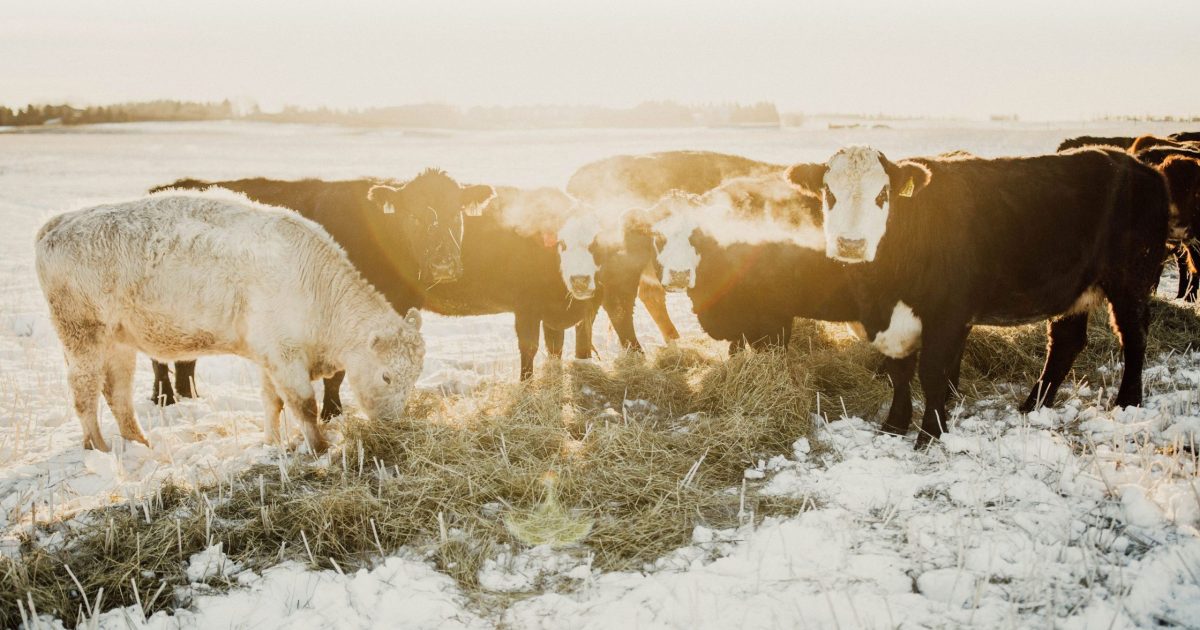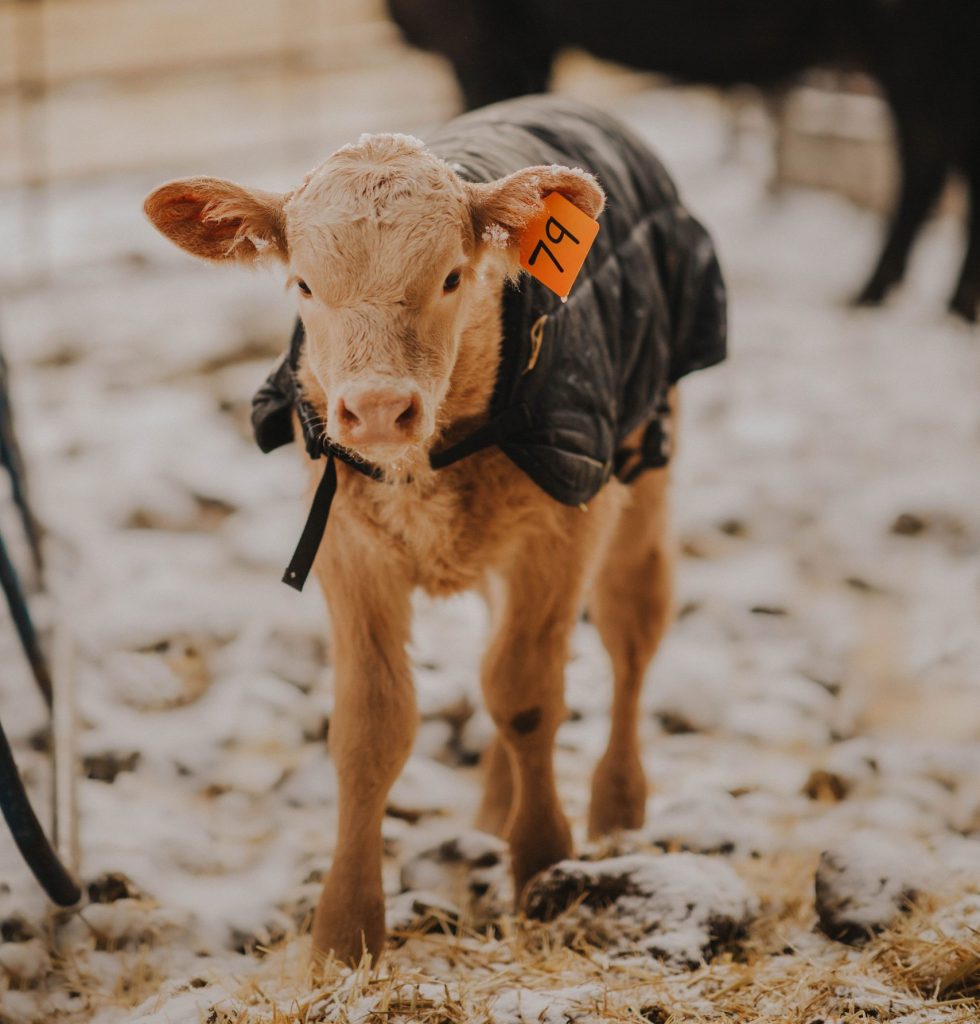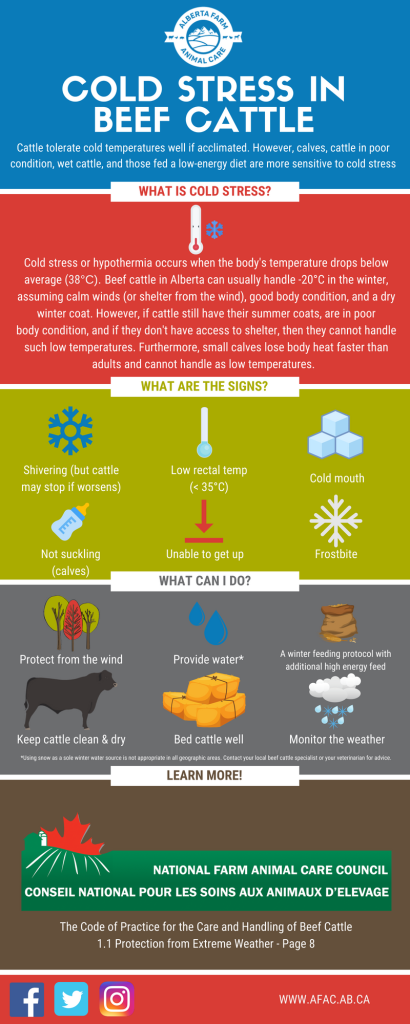AB Direct - Steers
Rail: 493.00-495.00 del
AB Direct - Heifers
Rail: 493.00-495.00 del
US Trade- Steers
Rail: 355.00 (IA, NE)
US Trade - Heifers
Rail: 355.00 (IA, NE)
Canadian Dollar
0.06

Cold Stress: What to know going into this winter
What is cold stress?

All mammals need to maintain their internal body temperatures, averaging 38°C in cattle. However, they don’t need to use extra energy to maintain normal body temperatures when the environmental conditions are within a “thermoneutral zone.” The thermoneutral zone is defined as the range of ambient temperatures without regulatory changes in metabolic heat production or evaporative heat loss.
When environmental temperatures drop below this zone, their body becomes stressed (hence the term cold stress). So, their body will increase its metabolic rate to maintain average temperatures. If the animal cannot maintain its body temperature, it will experience hypothermia. If severe enough, the animal will need medical intervention.
Below are estimates of lower critical temperatures for beef cattle. Keep in mind that these estimates do not consider various factors that may impact an animal’s threshold (e.g. condition of the animal and wind chill).
Estimates of lower critical temperatures for beef cattle in different seasons*
| Season | Lower Critical Temperature |
|---|---|
| Summer | 15°C |
| Fall | 7°C |
| Early winter | 0°C |
| Late winter | -8°C |
*Assuming that the animal is not susceptible to cold stress due to age, disease, poor condition, poor hair coat, and no wind chill.
Why may cold stress be more of a concern this year?
Most of the beef cattle raised in Canada acclimate to winter quickly. Very young, old, and ill animals are more susceptible to cold stress, especially those without good fat coverage.
This is why we recommend that cattle should be in good condition going into winter (i.e., Body Condition Score of 3). However, this may be a challenge for beef producers due to the recent drought and feed shortages.
What are the signs of cold stress in beef cattle?
In beef cattle, the following are signs of cold stress.
- Calves won’t suckle a bottle or fingers
- Depression, fatigue, unwillingness to move, and going down
- Fresh frostbite
- Low body temperature (<35°C)
- Pale gums
- Shivering (but may stop if the condition becomes severe)
- Skin or mouth is cold to the touch
What can farmers do to support their cattle?
The best thing farmers can do to support their cattle this winter is to assess their body condition before exposure to cold temperatures. This MUST be done by touching your animals, getting a true sense of how much fat coverage each animal has and then grouping your cattle as follows.
1. Cull animals – these are the animals that are too thin, old, or sick to make it through the winter. With current feed shortages, we need to optimize the health of the animals we choose to keep and not stretch our feed too far. Cull your animals before their condition starts to deteriorate, and they become compromised or unfit for transport.
2. Thin and old animals – these animals are not in such poor condition that they must be culled, and the producer is confident that they can improve their condition in time for winter. Routinely monitor for signs of cold stress.
3. Bred heifers and second calvers – these animals are in good condition but still growing, so they need more nutritional support. Monitor closely for signs of cold stress when temperatures drop.
4. Mature animals in good condition – these animals are in good condition and would typically fare well over winter. Monitor closely for signs of cold stress when temperatures drop.
If natural windbreaks (e.g., a tree line) are not available, man-made barriers can be used (e.g., snow fencing) to protect the animals from the wind. Bed your animals to keep them dry and off the cold ground.
A winter-feeding protocol is needed for the groups discussed above. Producers must also ensure that water is always available. Although snow can be a source of water for beef cattle, conditions need to be just right for them to rely on it as a source of water.
Finally, producers must monitor the weather closely throughout the winter to anticipate when their cattle will need extra support (e.g., supplementing high-energy feed) to combat cold stress.
Where can you find more information?
ALERT Line is an anonymous producer-helping-producer call line. If you have questions or concerns about animal welfare, including if you need support, call this number: 1-800-506-2273.
AFAC Website – There is information for practically every livestock species raised in Alberta on the AFAC website.
Agricultural Fieldmen – Agricultural fieldmen develop, implement, and control programs set out by the Agricultural Service Board. Find a directory of Agricultural Fieldmen online.
This article was first published in Volume 1 Issue 4 edition of ABP Magazine (November 2021). Watch for more digital content from the magazine on ABP Daily.


